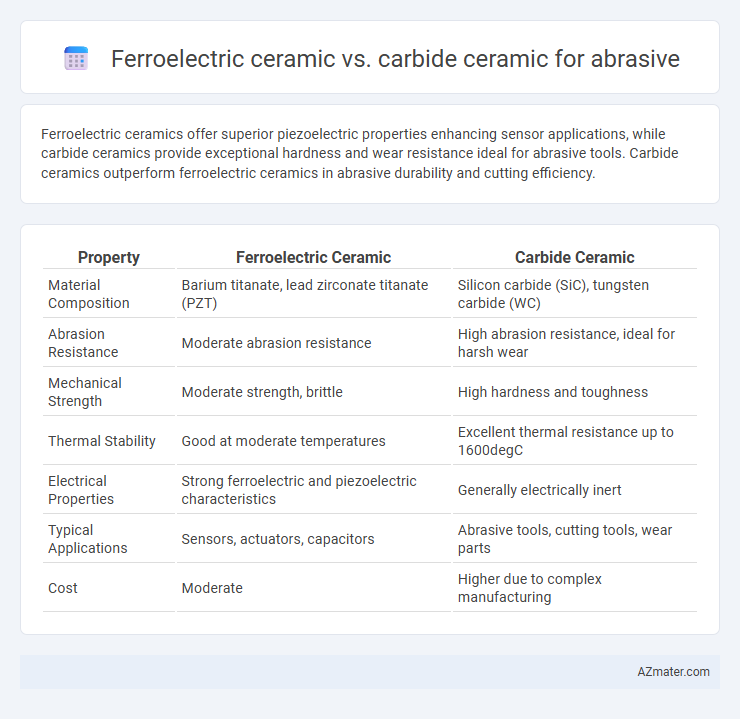Ferroelectric ceramics offer superior piezoelectric properties enhancing sensor applications, while carbide ceramics provide exceptional hardness and wear resistance ideal for abrasive tools. Carbide ceramics outperform ferroelectric ceramics in abrasive durability and cutting efficiency.
Table of Comparison
| Property | Ferroelectric Ceramic | Carbide Ceramic |
|---|---|---|
| Material Composition | Barium titanate, lead zirconate titanate (PZT) | Silicon carbide (SiC), tungsten carbide (WC) |
| Abrasion Resistance | Moderate abrasion resistance | High abrasion resistance, ideal for harsh wear |
| Mechanical Strength | Moderate strength, brittle | High hardness and toughness |
| Thermal Stability | Good at moderate temperatures | Excellent thermal resistance up to 1600degC |
| Electrical Properties | Strong ferroelectric and piezoelectric characteristics | Generally electrically inert |
| Typical Applications | Sensors, actuators, capacitors | Abrasive tools, cutting tools, wear parts |
| Cost | Moderate | Higher due to complex manufacturing |
Introduction to Abrasive Ceramics
Abrasive ceramics are engineered materials designed for high wear resistance, hardness, and thermal stability, essential for cutting, grinding, and polishing applications. Ferroelectric ceramics exhibit unique piezoelectric properties, enabling self-sensing and adaptive abrasive tools, while carbide ceramics, composed mainly of tungsten or silicon carbide, offer superior hardness and toughness for extreme abrasion conditions. Understanding the distinctions in microstructure and functional properties between ferroelectric and carbide ceramics helps optimize their use in precision abrasive technologies and industrial manufacturing processes.
Overview of Ferroelectric Ceramics
Ferroelectric ceramics exhibit spontaneous electric polarization that can be reversed by an external electric field, making them essential in sensors, actuators, and memory devices. Their crystalline structure, typically perovskite-type like barium titanate (BaTiO3), offers high dielectric permittivity and piezoelectric properties, which differ significantly from the chemical inertness and extreme hardness of carbide ceramics such as silicon carbide (SiC). While carbide ceramics excel in mechanical abrasion and thermal stability, ferroelectric ceramics contribute functional properties that enhance precision and responsiveness in specialized abrasive applications rather than sheer hardness.
Overview of Carbide Ceramics
Carbide ceramics, primarily composed of silicon carbide (SiC) or tungsten carbide (WC), exhibit exceptional hardness and thermal stability, making them ideal for abrasive applications requiring high wear resistance. These materials maintain structural integrity under extreme mechanical stress and high temperatures, outperforming many other ceramics in cutting and grinding tasks. Their superior fracture toughness and chemical inertness ensure longer tool life and consistent performance in abrasive environments compared to ferroelectric ceramics.
Material Properties Comparison
Ferroelectric ceramics exhibit high dielectric constants and piezoelectric properties, making them suitable for sensing and actuator applications but generally lack the hardness and wear resistance required for abrasive uses. In contrast, carbide ceramics such as silicon carbide or tungsten carbide offer exceptional hardness, high fracture toughness, and superior thermal stability, which are critical for abrasive performance and durability. The superior abrasion resistance and mechanical strength of carbide ceramics make them the preferred choice over ferroelectric ceramics in demanding abrasive environments.
Mechanical Strength and Toughness
Ferroelectric ceramics exhibit moderate mechanical strength but generally fall short in toughness compared to carbide ceramics, which are known for superior hardness and exceptional fracture toughness. Carbide ceramics, such as silicon carbide or tungsten carbide, provide enhanced wear resistance and durability, making them ideal for abrasive applications requiring prolonged service life. The higher toughness of carbide ceramics minimizes crack propagation, ensuring better mechanical performance under intense abrasive conditions.
Abrasive Performance and Wear Resistance
Ferroelectric ceramics exhibit moderate abrasive performance with enhanced electrical properties but generally lower wear resistance compared to carbide ceramics. Carbide ceramics, such as silicon carbide and tungsten carbide, offer superior hardness and abrasion resistance, making them ideal for high-performance abrasive applications requiring prolonged durability. The wear resistance of carbide ceramics surpasses that of ferroelectric ceramics due to their greater hardness and chemical stability under extreme conditions.
Thermal Stability and Conductivity
Ferroelectric ceramics exhibit moderate thermal stability with dielectric properties that degrade at high temperatures above 300degC, limiting their use in high-temperature abrasive applications. Carbide ceramics, such as silicon carbide and tungsten carbide, offer superior thermal stability exceeding 1000degC and exceptional thermal conductivity, enabling efficient heat dissipation during abrasive processes. The high thermal conductivity of carbide ceramics reduces thermal damage and tool wear, making them preferred materials for abrasive cutting and grinding under thermal stress conditions.
Cost and Manufacturing Considerations
Ferroelectric ceramics generally exhibit higher raw material and processing costs compared to carbide ceramics, largely due to their complex composition and specialized sintering techniques. Carbide ceramics, such as tungsten carbide, benefit from well-established manufacturing processes that enable cost-effective mass production and consistent abrasive performance. The processing of ferroelectric ceramics demands precise control over phase purity and crystal orientation, increasing manufacturing complexity and expenses relative to the relatively straightforward fabrication of carbide abrasives.
Typical Applications in Abrasive Industries
Ferroelectric ceramics are primarily used in precision grinding and polishing applications due to their high piezoelectric response, enabling fine control in abrasive processes for semiconductor wafers and optical components. Carbide ceramics, specifically silicon carbide and tungsten carbide, dominate in heavy-duty abrasive applications such as cutting tools, grinding wheels, and wear-resistant coatings due to their exceptional hardness and thermal stability. Typical abrasive industry applications leverage ferroelectric ceramics for delicate surface finishing, while carbide ceramics are preferred for high-load, high-speed material removal tasks.
Future Trends and Innovations
Ferroelectric ceramics exhibit superior polarization characteristics and tunable dielectric properties, making them promising candidates for advanced piezoelectric abrasive sensors and smart grinding systems. Carbide ceramics, renowned for exceptional hardness and thermal stability, are evolving through nanostructuring and doping techniques to enhance wear resistance and fracture toughness in high-precision abrasive applications. Future innovations focus on integrating ferroelectric ceramic-based smart monitoring with carbide ceramic abrasives to achieve adaptive, high-efficiency machining processes in Industry 4.0 environments.

Infographic: Ferroelectric ceramic vs Carbide ceramic for Abrasive
 azmater.com
azmater.com